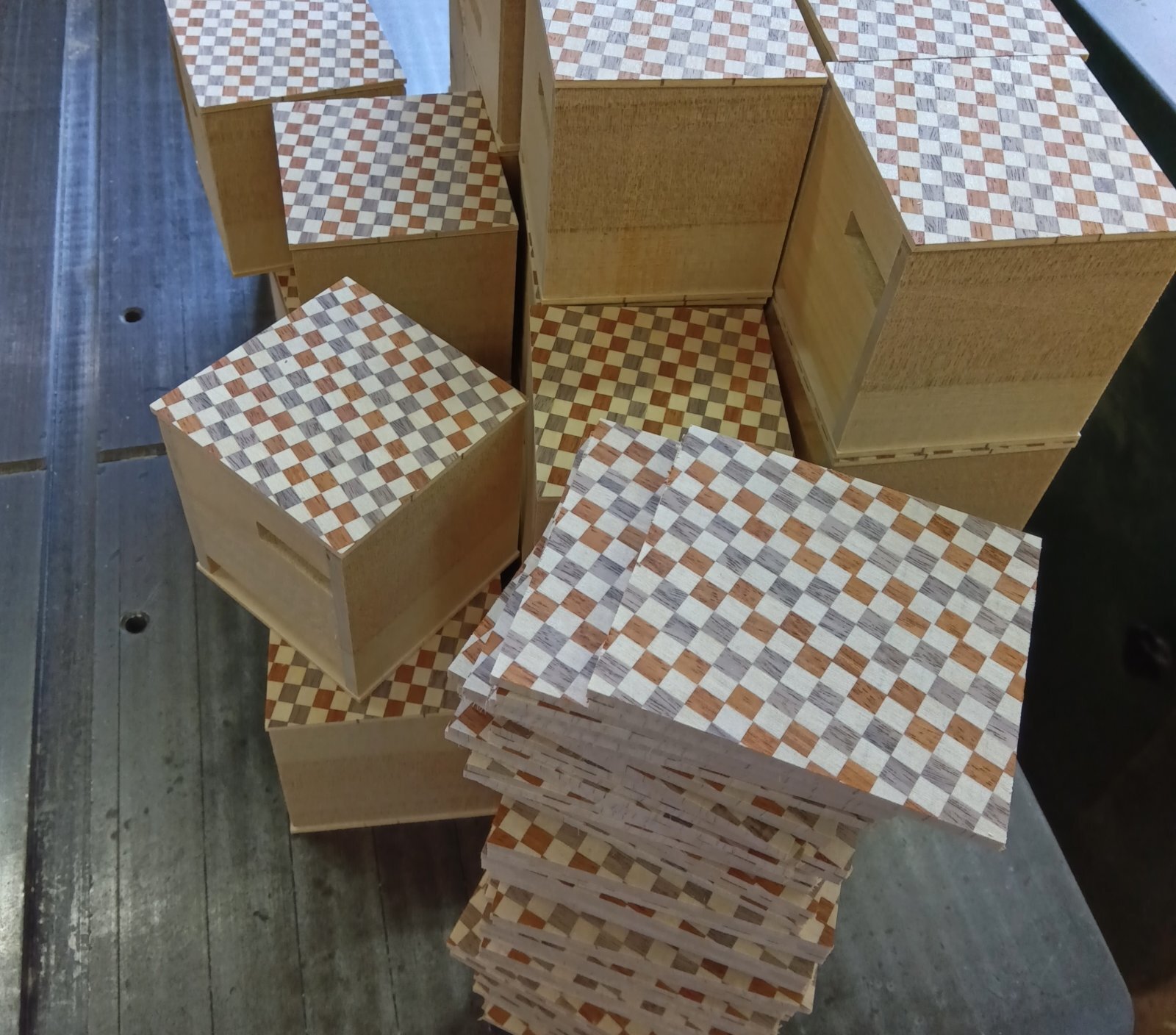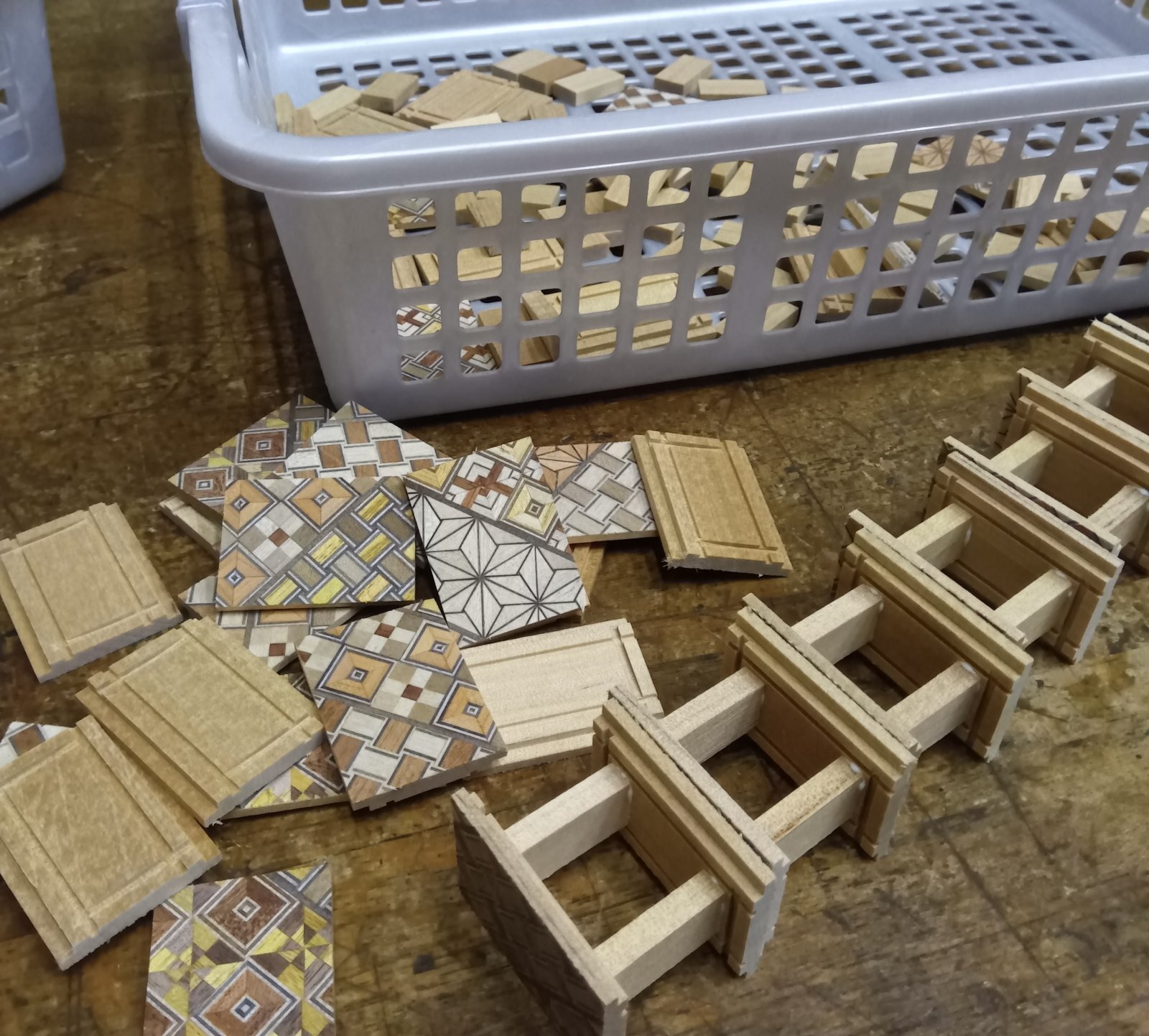3 sun cube box (4)
Today, I started with attaching the outer panels (Ichimatsu Yosegi panels) to the 3-sun cube Japanese puzzle box. Within one day, I plan to attach both the top and bottom panels and the side panels (photo). Normally, these steps are completed over two days, one step per day, but it’s possible to complete both in a single day because I use plywood for the top panel.
Typically, when attaching panels to the box, the glue’s moisture causes the panels to warp, requiring them to be fixed in place overnight until they stabilize. However, plywood doesn’t warp, allowing me to proceed to the next step after just a few hours. There are other reasons for using plywood, but this is one of the main advantages, which is why I use it for the top and bottom panels. By leaving the side panels fixed overnight starting today, I will be able to move on to the next step: attaching the final panels (Kannuki panels).
Today, I also started working on Mame puzzle boxes. Although the quantity is small this time (about 30 pieces), I decided to make them because there’s currently no stock available. The ones I’m making now are the standard 14-step version. The Yosegi sheets for these Mame puzzle boxes had already been attached to the boards in advance.
I often prepare the Yosegi sheets on boards during free time so I can start making Mame puzzle boxes at any moment. Today, I completed the frame parts and their assembly (photo). The next step will be crafting the Aruki panels.
As I mentioned in yesterday’s blog, I plan to start making 2.5-sun puzzle boxes after this, which is why these Mame puzzle boxes are needed. It’s rare for 2.5-sun boxes to be sold on their own; they are usually sold as a set with Mame puzzle boxes, creating a nested set, at any store.
I went to the home improvement store yesterday, but the Christmas items I was looking for were already limited, and New Year’s products were the main focus. We usually buy a few items for the New Year celebration. A common purchase is something like an ornament to decorate the entrance (called "Shogatsu Kazari" in Japan) and figurines of the animals (called "Jûnishi"). The animals changes every year and consists of 12 animals in total. Next year (2025) is the Year of the Snake, so many snake-themed decorations and figurines are being sold in stores🐍
Typically, when attaching panels to the box, the glue’s moisture causes the panels to warp, requiring them to be fixed in place overnight until they stabilize. However, plywood doesn’t warp, allowing me to proceed to the next step after just a few hours. There are other reasons for using plywood, but this is one of the main advantages, which is why I use it for the top and bottom panels. By leaving the side panels fixed overnight starting today, I will be able to move on to the next step: attaching the final panels (Kannuki panels).
Today, I also started working on Mame puzzle boxes. Although the quantity is small this time (about 30 pieces), I decided to make them because there’s currently no stock available. The ones I’m making now are the standard 14-step version. The Yosegi sheets for these Mame puzzle boxes had already been attached to the boards in advance.
I often prepare the Yosegi sheets on boards during free time so I can start making Mame puzzle boxes at any moment. Today, I completed the frame parts and their assembly (photo). The next step will be crafting the Aruki panels.
As I mentioned in yesterday’s blog, I plan to start making 2.5-sun puzzle boxes after this, which is why these Mame puzzle boxes are needed. It’s rare for 2.5-sun boxes to be sold on their own; they are usually sold as a set with Mame puzzle boxes, creating a nested set, at any store.
I went to the home improvement store yesterday, but the Christmas items I was looking for were already limited, and New Year’s products were the main focus. We usually buy a few items for the New Year celebration. A common purchase is something like an ornament to decorate the entrance (called "Shogatsu Kazari" in Japan) and figurines of the animals (called "Jûnishi"). The animals changes every year and consists of 12 animals in total. Next year (2025) is the Year of the Snake, so many snake-themed decorations and figurines are being sold in stores🐍

